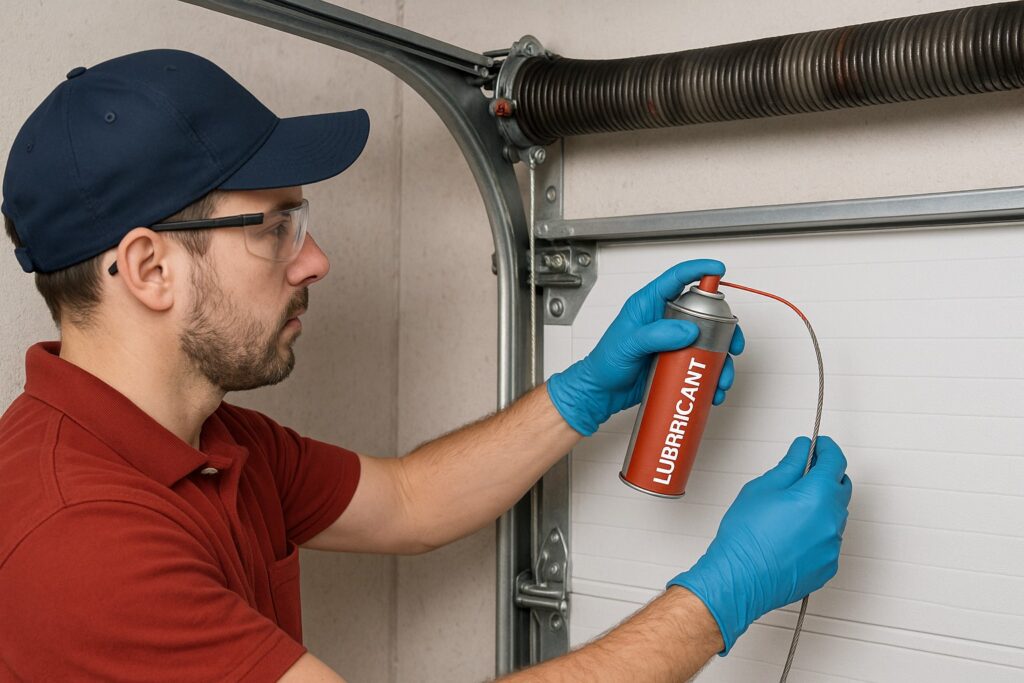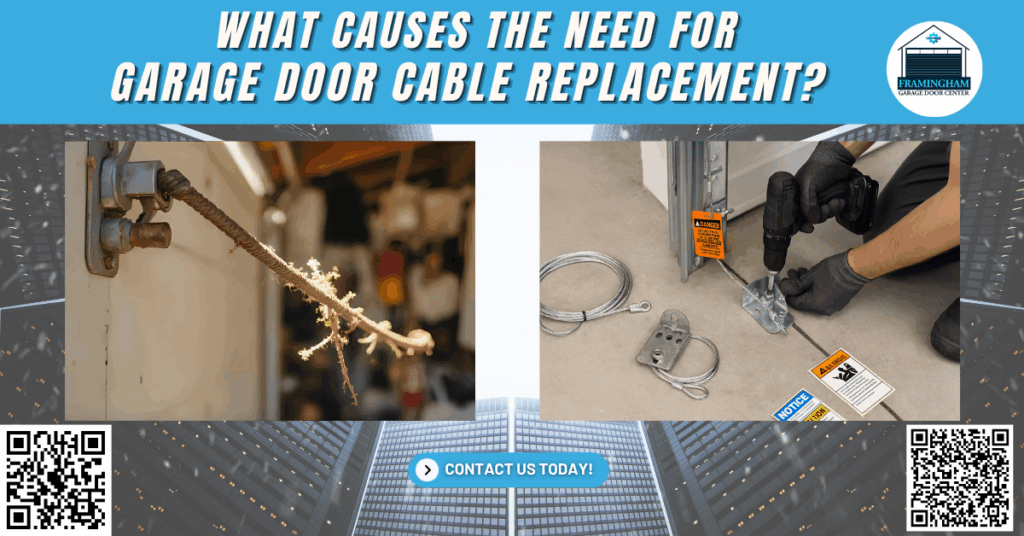Picture this: It’s a frigid morning in Attleboro, MA, and you’re already behind schedule. You click your garage door opener, expecting the door to rise as it always does. Instead, it jerks, makes a loud snap, and comes crashing down. Not only is your car stuck inside, but you’re now dealing with a potentially dangerous situation. When our team at Framingham Garage Door Center arrived, we found a broken garage door cable tangled around the cable drum, having snapped due to years of wear and tear, and a heavily corroded pulley system. This kind of issue is more common than most homeowners realize.
Garage doors are among the largest moving systems in any home. Their safe operation depends on a well-balanced system of torsion springs, door cables, drums, and brackets. If any one part fails, the entire garage door system becomes compromised. Among these components, garage door cables play a pivotal role in ensuring smooth operation and safety. According to industry research, more than 40% of emergency garage door repair services involve some form of garage door cable replacement.
Understanding the reasons behind the need for garage door cable replacement is critical not only for preventing damage but also for ensuring your family’s safety. In this guide, we’ll explore the causes, signs, and prevention of cable issues and offer step-by-step insights into why professional help is often the smartest route. Whether you own a home or manage a commercial property, this comprehensive article will help you protect your garage door investment.
Understanding the Role of Garage Door Cables
Garage door cables are heavy-duty wires that operate under high tension. They work alongside torsion springs or extension springs to lift and lower the door evenly. When you use your garage door opener, the torsion springs wind and unwind, transferring tension through the cables to move the door along the tracks.
There are two main types of garage door cables:
- Lift Cables – Common in torsion spring systems. They attach to the bottom brackets and wrap around the cable drum at each end of the torsion tube. These cables bear the majority of the load when the garage door is opening or closing.
- Retaining Cables – Found in extension spring systems, these cables run through the center of the springs to keep them from flying loose if they snap. They act as a safety measure to prevent injury or damage.
Garage door cables are essential for safe and reliable operation. If these cables fail, the springs can no longer control the movement of the door, increasing the risk of the door crashing down and causing injury or damage. These cables also help balance the door’s weight, ensuring a smooth and even motion during operation.
Common Causes of Garage Door Cable Replacement
Understanding the typical causes of garage door cable failure can help prevent unexpected breakdowns and costly repairs. Here are the most common reasons cables need to be replaced:
1. Natural Wear and Tear
Garage door cables are under constant tension and are used multiple times daily. Over time, this tension causes the cables to fray, stretch, and weaken. The repeated cycles of winding and unwinding create fatigue in the metal strands, particularly at stress points such as near the cable drum or bottom bracket. Especially in busy households or commercial properties, cables may wear out in as little as 5 to 7 years. As they age, the metal strands begin to separate, weakening the cable’s overall strength and leading to frayed ends.
2. Rust and Corrosion
Exposure to moisture, especially in humid climates like Massachusetts, can cause garage door cables to rust. When metal corrodes, it loses its structural integrity, making it brittle and prone to breakage. Rust also causes the cables to catch on pulleys or drums, leading to tangling and fraying. Salty air, rain, snow, and road salt in winter further accelerate corrosion. Once corrosion begins, it spreads rapidly and may compromise the pulley system, springs, and brackets as well.
3. Lack of Maintenance
Routine maintenance, such as lubricating the cables and inspecting the pulley system, can prevent early failure. Without regular upkeep, grime and dirt build up, increasing friction and wear on the cables and other parts like the torsion springs and bottom brackets. Failure to clean and inspect cables can also lead to unnoticed frays or loose hardware, which could result in the sudden failure of the garage door system. Routine maintenance not only extends the life of cables but also ensures overall system reliability.
4. Improper Installation or Low-Quality Parts
Installing old cables or using incorrect tension during setup may lead to premature failure. DIY repairs without the right tools or technical knowledge often cause more harm than good. Improper cable winding, mismatched cable lengths, or the use of substandard materials can cause excessive stress on the system, leading to early wear. Using the wrong size of cable drum or pulley can also throw off the door balance, making the cables work harder than necessary.
5. Broken Springs or Other Damaged Components
If a garage door spring breaks, the remaining tension shifts directly to the cables. Most cables are not designed to bear the full load, leading to breakage. Similarly, if the cable drum or pulley becomes misaligned, it may cause the cable to unwind unevenly or slip off entirely. Broken bottom brackets, misaligned tracks, and bent torsion tubes can also cause the cables to wear abnormally or snap unexpectedly.
Warning Signs of a Failing Garage Door Cable
Catching a worn or damaged cable early can prevent further damage and injury. Here are the signs homeowners and property managers should look for:
- Door Slams Shut: Indicates a total loss of spring tension or a broken cable.
- Lopsided Garage Door: A clear sign that one cable has slipped or broken.
- Frayed or Rusty Cables: Easily seen upon visual inspection near the bottom bracket or along the track.
- Strange Noises: Popping or grinding sounds often mean cables are slipping from the drum.
- Slow or Jerky Movement: This could be due to improper cable tension or cables getting caught in the pulley system.
- Visible Sagging of the Cable: If the cable is loose or appears to be hanging off the drum or bracket, it may be compromised.
- Opener Struggles or Stops: A cable issue can put strain on the garage door opener, causing it to stop unexpectedly.
For safety, it’s critical to turn off your garage door opener and call for professional garage door repair services if any of these signs are present. Continuing to operate the door with a broken cable may cause further damage or result in complete system failure.
The Dangers of Ignoring Cable Damage
Garage door cables support the entire weight of the door. A typical garage door can weigh between 130 to 400 pounds. If the cables snap, that weight is no longer controlled, turning your garage door into a falling hazard.
Ignoring a broken cable may lead to:
- Severe property damage: A crashing door can damage vehicles, floors, and other property.
- Injury to family members or pets: A falling door is a serious safety threat.
- Torsion spring failure: Overstressed springs may snap violently, creating dangerous projectiles.
- Damage to the garage door opener: A jammed or unbalanced door may burn out the opener motor.
- Increased repair costs: Delayed maintenance can lead to more complex and expensive repairs.
We’ve seen cases where homeowners suffered thousands of dollars in additional damage by waiting too long to replace old cables. Prevention is always safer and cheaper.
Step-by-Step Guide to Garage Door Cable Replacement (Why It’s Not a DIY Job)
While we admire the DIY spirit, replacing garage door cables is a task best left to professionals. Here’s an overview of the steps involved:
- Disconnect the Opener: Unplug the garage door opener and pull the emergency release cord to disengage the door.
- Open the Door Manually: Lift the door and clamp it in place with locking pliers to prevent it from falling.
- Release Spring Tension: Using winding bars, slowly unwind torsion springs to release stored energy. This step requires extreme caution and personal protective equipment (PPE) such as safety glasses and gloves.
- Remove Old Cable: Detach the frayed or broken cable from the bottom bracket and unwind it from the cable drum.
- Inspect Components: Check for damage to the drum, pulley, springs, and brackets before proceeding.
- Install New Cable: Thread the new cable through the pulley or drum and secure it to the bottom bracket.
- Re-Tension the Springs: Wind the torsion springs back using precision tools and torque calculations.
- Test the Door: Reconnect the opener and check the door for smooth operation, proper alignment, and tension balance.
Professionals have the right tools, including winding bars, torsion spring gauges, and PPE, to perform this process safely and effectively. DIY attempts often lead to injuries or further damage due to the high-tension nature of these components.
Commercial vs. Residential Cable Replacement
Commercial garage doors are typically larger and heavier, often using dual torsion spring systems. These systems operate under significantly more tension and require specialized parts and tools. Businesses should never delay cable repairs, as this can lead to downtime and safety risks for employees.
Commercial properties may also have:
- Heavy-duty bottom brackets
- Reinforced cable drums
- Overhead sectional doors
- Higher cycle requirements (open/close 50+ times daily)
At Framingham Garage Door Center, we offer:
- On-demand service calls
- Maintenance plans for warehouses and storefronts
- Emergency cable replacement
- Scheduled inspections for high-use systems
Maintenance Tips to Extend the Life of Your Garage Door Cables
Preventive maintenance helps you avoid emergency garage door repairs. Follow these simple steps:
- Lubricate Monthly: Use a silicone-based spray on cables, drums, pulleys, and springs to reduce friction.
- Inspect Seasonally: Look for signs of fraying, corrosion, or loose setscrews every few months.
- Clean Tracks and Hardware: Use a dry cloth to remove debris that could disrupt cable alignment.
- Test Door Balance: Disconnect the opener and manually lift the door. It should stay in place at mid-height. If not, tension may need adjustment.
- Schedule Professional Tune-Ups: At least once a year for homes, quarterly for commercial systems.
- Avoid Overuse or Slamming: Educate family members to gently open and close the door and never use it as an entrance more than necessary.
- Install Weather Seals: Keep out moisture and debris that can corrode metal parts.

Final Thoughts: Keeping Your Garage Door Safe and Reliable
Your garage door system works hard every day. The cables, though often overlooked, are essential for keeping your home safe and functional. Regular maintenance, prompt repairs, and attention to early warning signs can save you money and keep your family out of harm’s way.
Whether you’re dealing with a broken cable, a noisy garage door, or are simply due for a routine inspection, never underestimate the importance of garage door cables in the system’s overall health. Treat cable replacement as a necessary part of ongoing garage door maintenance, just like you would with your vehicle’s brakes or tires.
By investing in high-quality parts, scheduling routine maintenance, and trusting trained professionals for your repairs, you ensure that your garage door remains reliable, safe, and ready to serve your family or business for years to come.
How Can Framingham Garage Door Center Help You?
At Framingham Garage Door Center, we specialize in professional garage door cable replacement, garage door repair, and full system maintenance. Our team is trained to handle every issue, from a snapped cable to complete garage door installation.
We provide:
- Same-day and emergency garage door repairs
- Expert cable drum and bottom bracket adjustments
- Torsion spring tuning and safety inspections
- Replacement of broken cables, old cables, and damaged parts
- Reliable service for residential and commercial properties
Serving Attleboro, MA, Framingham, and surrounding towns, we take pride in fast, affordable, and friendly service. Whether you need help with your home or business, we bring the right tools and professional knowledge to every job.
📍 Address:19 Temple St GF, Framingham, MA 01702
📞 Phone: (508) 213-9614
Call us today or book online HERE to schedule your inspection or cable replacement. Don’t wait until a broken cable turns into a bigger problem. Let Framingham Garage Door Center help you maintain your garage door’s safe operation, step by step, with care.
Frequently Asked Questions (FAQs)
Can I open my garage door manually if the cable is broken?
It is not recommended, as doing so can be dangerous and may cause further damage to the garage door system.
What happens if a garage door cable comes off the drum?
The door may become unbalanced or jammed, and continued use can damage other parts like the springs or opener.
Are all garage door cables the same size?
No, cables come in different lengths and thicknesses depending on the door size, weight, and type of spring system.
How do I know if my garage door cables need lubrication?
If the cables appear dry, squeaky, or show signs of rust, they likely need lubrication with a silicone-based spray.

